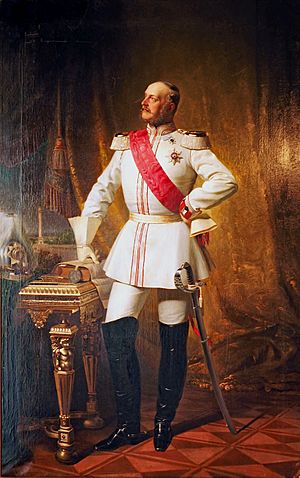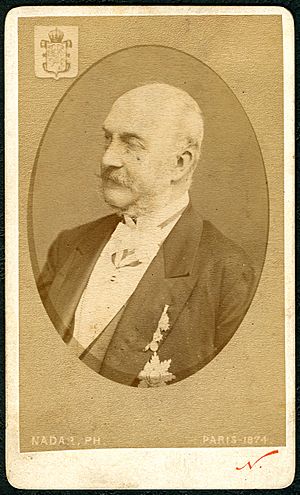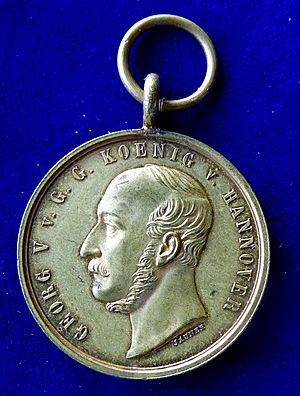George V of Hanover facts for kids
Quick facts for kids George V |
|||||
|---|---|---|---|---|---|
| Duke of Cumberland and Teviotdale | |||||

Portrait by Conrad L'Allemand, 1861, now in Celle Castle
|
|||||
| King of Hanover | |||||
| Reign | 18 November 1851 – 20 September 1866 |
||||
| Predecessor | Ernest Augustus | ||||
| Successor | Monarchy abolished | ||||
| Born | 27 May 1819 Berlin, Prussia |
||||
| Died | 12 June 1878 (aged 59) Paris, France |
||||
| Burial | 24 June 1878 Royal Vault, St George's Chapel, Windsor |
||||
| Spouse |
Marie of Saxe-Altenburg
(m. 1843) |
||||
| Issue | Ernest Augustus, Crown Prince of Hanover Princess Frederica, Baroness von Pawel-Rammingen Princess Marie |
||||
|
|||||
| House | Hanover | ||||
| Father | Ernest Augustus, King of Hanover | ||||
| Mother | Frederica of Mecklenburg-Strelitz | ||||
| Religion | Lutheran | ||||
| Signature | |||||
George V (Georg Friedrich Alexander Karl Ernst August; 27 May 1819 – 12 June 1878) was the last King of Hanover, the only child and successor of King Ernest Augustus. George V's reign was ended by the Austro-Prussian War, after which Prussia annexed Hanover.
Contents
Early life
Prince George of Cumberland was born on 27 May 1819 in Berlin, the only son of Prince Ernest Augustus, Duke of Cumberland and Teviotdale. Ernest Augustus was the fifth son of George III of the United Kingdom and his wife, Charlotte of Mecklenburg-Strelitz.
He was baptised on 8 July 1819 at a hotel in Berlin where his parents were staying, by the Rev. Henry Thomas Austen (brother of author Jane Austen). His godparents were the then Prince Regent George IV of the United Kingdom (represented by the Duke of Cumberland), King Frederick William III of Prussia, Emperor Alexander I of Russia, the Crown Prince of Prussia, Prince William of Prussia, Prince Frederick of Prussia, Prince Henry of Prussia, Prince Wilhelm of Prussia, the Grand Duke Georg of Mecklenburg-Strelitz, Duke Charles of Mecklenburg, Empress Maria Feodorovna, the Queen of the Netherlands Wilhelmine of Prussia, the Princess Augusta Sophia of the United Kingdom, the Hereditary Princess of Hesse-Homburg Princess Elizabeth of the United Kingdom, the Princess Mary (Duchess of Gloucester and Edinburgh), Princess Sophia of the United Kingdom, Princess Alexandrine of Prussia, the Electoral Princess Augusta of Hesse-Kassel, the Duchess of Anhalt-Dessau Princess Frederica Wilhelmina of Prussia, Princess Maria Anna of Hesse-Homburg (Princess William of Prussia), Margravine Elisabeth Louise of Brandenburg-Schwedt (Princess Ferdinand of Prussia), Princess Louisa of Prussia, and Princess Radziwill.
George spent his childhood in Berlin and in Great Britain. He lost the sight of one eye following a childhood illness in 1828, and in the other eye following an accident in 1833. His father had hoped that the young prince might marry his cousin Queen Victoria, who was older by three days, thus keeping the British and Hanoverian thrones united, but nothing came of the plan.
Crown Prince
Upon the death of King William IV and the accession of Queen Victoria to the British throne, the 123-year personal union of the British and Hanoverian thrones ended because Hanover's semi-Salic law prevented a woman from ascending its throne. The Duke of Cumberland succeeded to the Hanoverian throne as Ernest Augustus, and Prince George became the Crown Prince of Hanover. As a legitimate descendant of George III in the male line, he remained a member of the British royal family and second in line to the British throne until the birth of Queen Victoria's first child, Victoria, Princess Royal, in 1840. Since he was totally blind, there were doubts as to whether the Crown Prince was qualified to succeed as king of Hanover, but his father decided that he should do so.
Marriage
George married, on 18 February 1843, at Hanover, Princess Marie of Saxe-Altenburg, the eldest daughter of Joseph, Duke of Saxe-Altenburg, by his wife, Duchess Amelia of Württemberg.
King of Hanover
The Crown Prince succeeded his father as the King of Hanover and Duke of Brunswick-Lüneburg as well as Duke of Cumberland and Teviotdale, in the Peerage of Great Britain and Earl of Armagh, in the Peerage of Ireland, on 18 November 1851, assuming the style George V.
From his father and from his maternal uncle, Prince Charles Frederick of Mecklenburg-Strelitz, one of the most influential men at the Prussian court, George had learned to take a very high and autocratic view of royal authority. During his 15-year reign, he engaged in frequent disputes with the Hanoverian Landtag (parliament).
George was generally supportive of Austria in the Diet of the German Confederation. As the Austro-Prussian War started, the Prussian government sent a dispatch on 15 June 1866 demanding that Hanoverian troops submit to their authority or face war. Despite previously having concluded that Hanover could not win an armed confrontation with Prussia, George remained protective of his throne and refused the ultimatum. Contrary to the wishes of the parliament, Hanover joined the Austrian camp in the war. As a result, the Prussian army occupied Hanover and the Hanoverian army surrendered on 29 June 1866 following the Battle of Langensalza, the King and royal family having fled to Austria. The Prussian government formally annexed Hanover on 20 September 1866, despite the King of Prussia, William I, being a first cousin of King George V of Hanover; their mothers were sisters. The deposed King never renounced his rights to the defunct throne or acknowledged Prussia's actions. From exile in Gmunden, Austria, he appealed in vain for the European great powers to intervene on behalf of Hanover. From 1866 to 1870, George V maintained the Guelphic Legion partially at his own expense.
While in exile, he was appointed an honorary full general in the British army in 1876.
Death
George V died at his residence in the Rue de Presbourg, Paris, on 12 June 1878. After a funeral service in the Lutheran Church at the Rue Chaucat, his body was removed to England and buried in St George's Chapel at Windsor Castle.
Legacy
The King supported industrial development. In 1856 the "Georgs-Marien-Bergwerks- und Hüttenverein" was founded which was named after him and his wife. The company erected an iron and steel works which gave the city Georgsmarienhütte its name.
Titles, styles, honours and arms
Titles and styles
- 27 May 1819 – 20 June 1837: His Royal Highness Prince George of Cumberland
- 20 June 1837 – 18 November 1851: His Royal Highness The Crown Prince of Hanover
- 18 November 1851 – 12 June 1878: His Majesty The King of Hanover
Honours
 Kingdom of Hanover:
Kingdom of Hanover:
- Sovereign and Grand Cross of the Royal Guelphic Order, 1825
- Sovereign and Knight of St. George, 1839
- Founder and Sovereign of the Order of Ernst August, 15 December 1865
 United Kingdom: Knight of the Garter, 15 August 1835
United Kingdom: Knight of the Garter, 15 August 1835 Ascanian duchies: Grand Cross of Albert the Bear, 16 June 1840
Ascanian duchies: Grand Cross of Albert the Bear, 16 June 1840 Austrian Empire:
Austrian Empire:
- Grand Cross of St. Stephen, 1843
- Commander of the Military Order of Maria Theresa, 1866
 Baden:
Baden:
- Knight of the House Order of Fidelity, 1855
- Grand Cross of the Zähringer Lion, 1855
 Kingdom of Bavaria: Knight of St. Hubert, 1852
Kingdom of Bavaria: Knight of St. Hubert, 1852 Brunswick: Grand Cross of Henry the Lion
Brunswick: Grand Cross of Henry the Lion Belgium: Grand Cordon of the Order of Leopold, 25 May 1853
Belgium: Grand Cordon of the Order of Leopold, 25 May 1853 Denmark: Knight of the Elephant, 23 November 1851
Denmark: Knight of the Elephant, 23 November 1851

 Ernestine duchies: Grand Cross of the Saxe-Ernestine House Order, August 1839
Ernestine duchies: Grand Cross of the Saxe-Ernestine House Order, August 1839 French Empire: Grand Cross of the Legion of Honour, 28 June 1860
French Empire: Grand Cross of the Legion of Honour, 28 June 1860 Mecklenburg: Grand Cross of the Wendish Crown, with Crown in Ore, 29 October 1865
Mecklenburg: Grand Cross of the Wendish Crown, with Crown in Ore, 29 October 1865 Oldenburg: Grand Cross of the Order of Duke Peter Friedrich Ludwig, with Golden Crown, 11 September 1841
Oldenburg: Grand Cross of the Order of Duke Peter Friedrich Ludwig, with Golden Crown, 11 September 1841 Kingdom of Prussia: Knight of the Black Eagle, 14 June 1838; with Collar, 1852
Kingdom of Prussia: Knight of the Black Eagle, 14 June 1838; with Collar, 1852 Saxe-Weimar-Eisenach: Grand Cross of the White Falcon, 27 May 1857
Saxe-Weimar-Eisenach: Grand Cross of the White Falcon, 27 May 1857 Kingdom of Saxony: Knight of the Rue Crown, 1852
Kingdom of Saxony: Knight of the Rue Crown, 1852 Spain: Knight of the Golden Fleece, 5 May 1865
Spain: Knight of the Golden Fleece, 5 May 1865
 Sweden-Norway: Knight of the Seraphim, 9 September 1852
Sweden-Norway: Knight of the Seraphim, 9 September 1852 Württemberg: Grand Cross of the Württemberg Crown, 1852
Württemberg: Grand Cross of the Württemberg Crown, 1852
Arms
By grant dated 15 August 1835, George's arms in right of the United Kingdom were those of his father (being the arms of the United Kingdom, differenced by a label argent of three points, the centre point charged with a fleur-de-lys azure, and each of the other points charged with a cross gules), the whole differenced by a label gules bearing a horse courant argent.
Issue
| Name | Birth | Death | Notes |
|---|---|---|---|
| Ernest Augustus, Crown Prince of Hanover | 21 September 1845 | 14 November 1923 | Ernest Augustus William Adolphus George Frederick; born at Hanover, died at Gmunden, married Princess Thyra of Denmark; had issue |
| Princess Frederica of Hanover | 9 January 1848 | 16 October 1926 | born at Hanover, died at Biarritz; married Alfons, Baron von Pawel-Rammingen; had no surviving issue |
| Princess Marie of Hanover | 3 December 1849 | 4 June 1904 | Marie Ernestine Josephine Adolphine Henrietta Theresa Elizabeth Alexandrina; born at Hanover, died unmarried at Gmunden |
See also
 In Spanish: Jorge V de Hannover para niños
In Spanish: Jorge V de Hannover para niños





